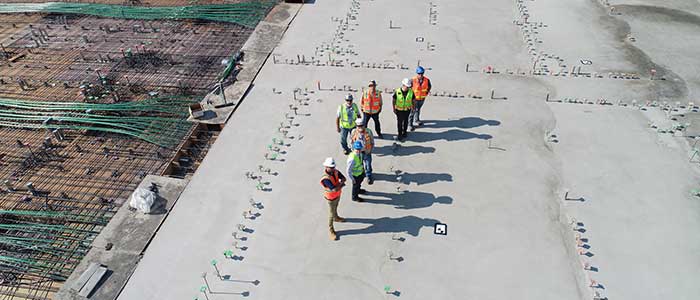Dashpivot article page – 3 ways to prevent slips trips and falls

3 ways to prevent slips, trips and falls in every workplace
Slip, Trip and Fall are among the most common contributor to work-related injuries. Injuries caused by slip, trip and fall can be minor like bruises, cuts and sprains, major injuries like a broken bone, fracture dislocation and severe sprains and it could be fatal especially from falling to a high elevation.
Depending on how severe the injury is, some would take a longer recovery time which brings physical pain and emotional turmoil to the workers and their families. It also calls for a financial burden to the employers and the company could fail important safety audit when it doesn’t meet the safety standards.
In this article we will go through 3 ways to preventing slips, trips and falls in every workplace.
Before going through ways to prevent slips, trips and fall let’s go over the most common causes of slips, trips and falls
- Poor lighting in designated work spaces
- Slippery and greasy floors that is either due to the design of work area, natural causes like floor is wet due to melted snow, flooding, and liquid or dry spills
- Rough and uneven surfaces
- Poor stairs or step design – includes having no handrails
- Lack of signages and warnings
- Clutter on the walkways
- Poor housekeeping
- Lack of proper personal protective equipment
- Lack of safety training and hazard awareness
- Unsafe behaviours by the workers
The 3 most common ways to prevent slips, trips and falls
Slips, trips and falls related accidents can be prevented in 3 straightforward ways by addressing the most common issues and resolving them.
Design a Safe Work Area
Many of the causes stated above can be mitigated by designing a safe work area. This means when the work area has a lot of traffic, good lighting should be part of the design.
While it is important to practice extreme caution, falling from ladders, steps and stairs are usually due to its set-up or design. Designing a safe work area is a preemptive way in preventing slips and falls - using well designed materials, marking designated paths to avoid collision and preparing the space by reviewing potential hazards.
Proper Housekeeping
Implementing proper housekeeping is a proven way to mitigate the causes of slips, trips and falls that are especially due to clutters and greasy floors. Utilising the “5S” methodology to promote proper housekeeping is an effective 5-step process. 5S stands for Sort, Set in Order, Shine, Standardise and Sustain. To prevent slips, trips and falls you can use 5S in this way:
Sort – Rid of clutters and unnecessary items in the workplace that potentially cause the obstruction and sort the needed tools and materials
Set In Order – After sorting, organise your tools and cables orderly by implementing a good storage solution with appropriate labels.
Shine - Immediately clean up liquid and dry spills to avoid having someone slide on it accidentally.
Standardise – Make standard procedure for workers to follow with respect to housekeeping to avoid slips, trips and falls.
Sustain – 5th and final step to make sure that the rest of 5S is sustained, this is by conducting 5S audit and checking if the standard procedures were followed.
Correct Unsafe Behavior by creating a safety mindset
Correct worker’s unsafe behavior by conducting a safety training regularly. Safety trainings should be consistent and frequent to create a safety mindset in relation to slip, trip and falls.
Creating safety mindset in the workplace ensures that workers make incident reports during near miss scenarios, call out hazards like housekeeping issues and sustain the 5S principle in the workplace. Provide opportunities for open communication and involve employees in the safety efforts of the company.
An effective way to foster safety mindset in the workplace is to conduct Toolbox Talks for Slips, Trips and Fall. Toolbox talks are brief informal safety meetings or pre-start lead by a team leader or supervisor that can be conducted ideally daily in the work area before starting the work. Toolbox talks for slips, trips and falls should cover topics that are relevant and related to it that could be openly discuss with the team in an organized format to make the flow easy to follow by the workers.
To communicate effectively, utilise this digital toolbox talk form for slips, trip and fall like the one below.

It is organized and section to have an easy flow and there’s a portion to input the notes raised by the attendees. This form was created by a reliable software called Dashpivot - it is free, easy to access and customisable. You can add new incidents of slips, trips and fall and discuss with the team the cause and how to prevent it. After the meeting, you can quickly conduct attendance by scanning their app ID.
This article covered 3 ways to prevent slip, trip and falls in every workplace: (1) design a safe work area, (2) implement proper housekeeping in the workplace by adapting a 5S method and finally (3) correcting unsafe behaviour by creating a safety mindset.

Safety Toolbox Talk template
This toolbox talk template is quick and easy to complete and signoff on site, and keeps all of your toolbox talks neatly organised and professional.

Toolbox Talk Noise Pollution template
Keep your team aware of noise pollution, ways to manage risks and reduce noise with this Toolbox Talk template.

Site Security Toolbox Talk template
Keep your team up to date with site security with this Toolbox Talk Site Security.